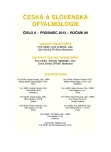Surgical Treatment of Very Advanced Rhegmatogenous Retinal Detachment
Authors:
L. Hejsek 1; J. Ernest 2; P. Němec 2; L. Rejmont 2; K. Manethová 2; A. Stepanov 1; P. Rozsíval 1
Authors‘ workplace:
Oční klinika, Fakultní nemocnice, Hradec Králové, přednosta prof. MUDr. Pavel Rozsíval, CSc., FEBO
1; Ústřední vojenská nemocnice, Vojenská fakultní nemocnice, Praha, přednosta doc. MUDr. Jiří Pašta, CSc., FEBO
2
Published in:
Čes. a slov. Oftal., 69, 2013, No. 6, p. 248-252
Category:
Original Article
Overview
Rhegmatogenous retinal detachment is a serious ocular pathology. Therapeutic options are surgical only. Surgery is in advanced stages technically and financially demanding. In this paper, we consider the results operated detachments, which were for their advancement, with respect to the technical possibilities of the present intraocular surgery, on the border of the surgical possibilities. The group consisted of 37 eyes of 37 patients who were followed prospectively and had in the affected eye very advanced (old) rhegmatogenous retinal detachment. As a method to confirtm any visual functions were used visual evoked potentials in flash monocular stimulation (F-VEP). All patients had a cerclage performed 12 mm from the limbus, 20G pars plana vitrectomy (PPV), in 2 was also performed cataract surgery (phacoemulsification with implantation of an artificial intraocular lens to the bag). Surgery was done in 23 of 37 patients (62 % of the whole group), with the remaining 14 eyes was not due to the severity of finding highly advanced retinal detachment. Attached retina at the end of the observation period had 14 eyes (61% of the patients, 38% of the whole group). In 5 eyes was due to local re-detachment in the periphery only stabilized finding (22% of operated eyes, 14% of all). The values of visual acuity in the subgroup of operated eyes were statistically significantly increased after surgery (Wilcoxon p = 0.036). The values of F-VEP were not statistically significantly different between operated and non-operated patients and was not found any statistically significant correlation between the vision (and even after surgery) and F-VEP in operated eyes. Anatomical success of surgical treatment of advanced retinal detachment is possible. But the correlation was not found in visual acuity and F-VEP or the severity of preoperative disturbed visual function, even in the improvement in the postoperative period. F-VEP is not a suitable marker for determining the indication for the procedure, or to the prognostics and therefore we can not use this technique to distinguish between operable and inoperable findings. Based on our clinical experience, we recommend carefully consider the suitability of surgical treatment of rhegmatogenous retinal detachment with low vision than the hand movement with the correct projection of light, when the duration is longer than three months and the anatomic findings is contractile anterior proliferative vitreoretinopathy.
Key words:
advanced retinal detachment, surgery, proliferative vitroretinopathy
Sources
1. Garkavi, RA., Bogoslovskii, AI.: Surgical therapy of old retinal detachment., Vestn Oftalmol, 1959; 72(1): 18–26.
2. Grover, S., Fishman, GA., Anderson, RJ., et al.: Visual acuity impairment in patients with retinitis pigmentosa at age 45 years and older. Ophthalmol, 1999, 106(9): 1780–1785.
3. Kanakis, M., Georgalas, I., Koutsandrea, C.: RNFL damage after treatment for retinal detachment., Invest Ophthalmol. 2013; 54(7): 5027.
4. Langrová, H., Kyprianou, G., Rozsíval, P.: Nové metody testování zrakové ostrosti, Trendy soudobé oftalmologie IV, Praha, Galén, 2007; 75–98.
5. Lean, J., Irvine, A., Stern, W. et al.: Classification of proliferative vitreoretinopathy used in the slilicone study., The Silicone Study Group. Ophthalmology, 1989; 96: 765–771.
6. Nelson, F.: Old retinal detachment., Am J Ophthalmol. 1950; 33(11): 1799–1800.
7. Schaal, S., Sherman, MP., Barr, CC., Kaplan, HJ.: Primary retinal detachment repair: comparison of 1-year outcomes of four surgical techniques. Retina, 2011; 31(8): 1500–1504.
Labels
OphthalmologyArticle was published in
Czech and Slovak Ophthalmology

2013 Issue 6
Most read in this issue
- Vision Loss after Uncomplicated Pars Plana Vitrectomy
- Treatment Strategy of the Lacrimal Drainage System Inborn Obstruction. Part One – Conservative and Intervention Procedures
- Cytomegalovirus Retinitis in HIV Negative Patients – Retrospective Study
- Pars Plana Vitrectomy Due to the Intravitreal Hemorrhage Caused by Persistent Hyaloid Artery in Three Children
